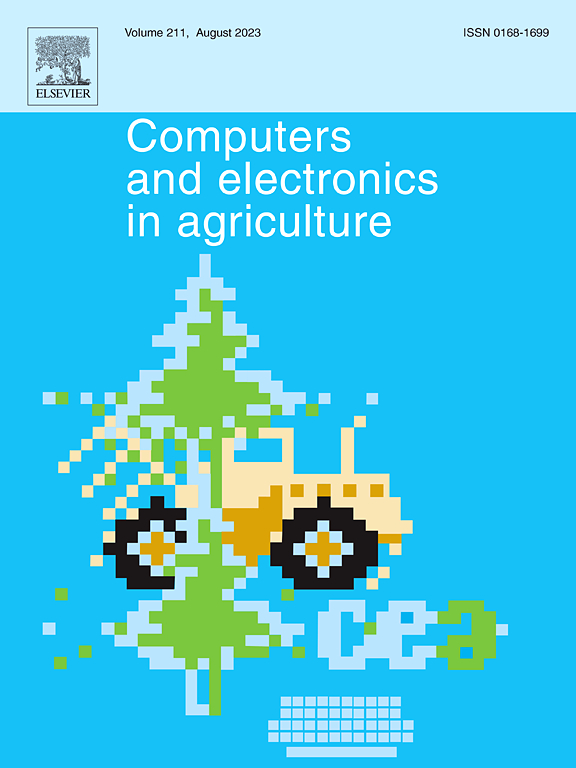基于移动-观察-收获协调和异步收获合作的白芦笋双臂机器人并联控制方法
IF 8.9
1区 农林科学
Q1 AGRICULTURE, MULTIDISCIPLINARY
引用次数: 0
摘要
针对高效、低伤害的白芦笋选择性采收机器人,提出了一种基于移动-看-采收协调和非同步采收配合的双臂并联控制方法。这种方法的目的是使沿着山脊连续,不间断的收获,同时尽量减少对矛的伤害。首先,设计了双臂独立收获区域的并联收获模式,减少了机械臂间的碰撞,简化了控制复杂度;其次,针对多个随机分布的芦笋,提出了一种高效的双臂协同采收算法。在此基础上,提出了一种移动-观察-收获的协调控制策略,实现了机器人在两个末端执行器的运动、芦笋识别和收获操作的同步。最后,构建了该系统的原型,并对其在田间的性能进行了评价。对协同收获算法的仿真分析表明,基于最短时间的首见收获(ST-FSH)路径规划策略优于两种备选方法。与单臂采收相比,双臂采收时间节省45.17%,采收成功率提高3.19%,同时保持工作量平衡。野外试验结果表明,该方法的芦笋识别率为82.6%,平均检测时间为33 ms,识别芦笋的成功率为92.3%,机械臂运动时间和末端执行器平均收获时间分别为1.7 s和5.7 s。该系统对芦笋的伤害率为7.2%。实验结果验证了所提出的高效、低伤害采收策略的可行性,为白芦笋选择性采收机器人的开发提供了坚实的基础。本文章由计算机程序翻译,如有差异,请以英文原文为准。
A parallel dual-arm robotic control method of white asparagus based on moving-looking-harvesting coordination and asynchronous harvest cooperation
For an efficient, low-damage selective harvesting robot for white asparagus, a parallel dual-arm control method based on moving-looking-harvesting coordination and asynchronous spears harvesting cooperation is proposed. This approach aims to enable continuous, non-stop harvesting along the ridge while minimizing damage to the spears. Firstly, a parallel harvesting mode with independent harvesting areas for the dual arms was designed to reduce collisions between the robotic arms and simplify control complexity. Secondly, an efficient dual-arm cooperative harvesting algorithm, aimed at load balancing for multiple randomly distributed asparagus, was proposed. Then, a coordinated moving-looking-harvesting control strategy was developed to synchronize the robot’s movement, asparagus identification, and the harvesting operation using the two end-effectors. Finally, a prototype of the selective harvesting system was constructed, and its performance was evaluated in the field. The simulation analysis of the cooperative harvesting algorithm indicated that the shortest-time-based first-see-harvest (ST-FSH) path planning strategy outperformed two alternative methods. The dual-arm harvesting saved 45.17 % of the time and increased the harvest success rate by 3.19 % compared with the single-arm harvesting, while maintaining workload balance. Field trials demonstrated an asparagus recognition rate of 82.6 %, with an average detection time of 33 ms, a successful harvest rate of 92.3 % for recognized asparagus, and average robotic arm movement time and end-effector harvest time of 1.7 s and 5.7 s, respectively. The system achieved an asparagus damage rate of 7.2 %. The results confirm the feasibility of the proposed efficient, low-damage harvesting strategy, providing a solid foundation for the development of selective harvesting robots for white asparagus.
求助全文
通过发布文献求助,成功后即可免费获取论文全文。
去求助
来源期刊

Computers and Electronics in Agriculture
工程技术-计算机:跨学科应用
CiteScore
15.30
自引率
14.50%
发文量
800
审稿时长
62 days
期刊介绍:
Computers and Electronics in Agriculture provides international coverage of advancements in computer hardware, software, electronic instrumentation, and control systems applied to agricultural challenges. Encompassing agronomy, horticulture, forestry, aquaculture, and animal farming, the journal publishes original papers, reviews, and applications notes. It explores the use of computers and electronics in plant or animal agricultural production, covering topics like agricultural soils, water, pests, controlled environments, and waste. The scope extends to on-farm post-harvest operations and relevant technologies, including artificial intelligence, sensors, machine vision, robotics, networking, and simulation modeling. Its companion journal, Smart Agricultural Technology, continues the focus on smart applications in production agriculture.
 求助内容:
求助内容: 应助结果提醒方式:
应助结果提醒方式:


